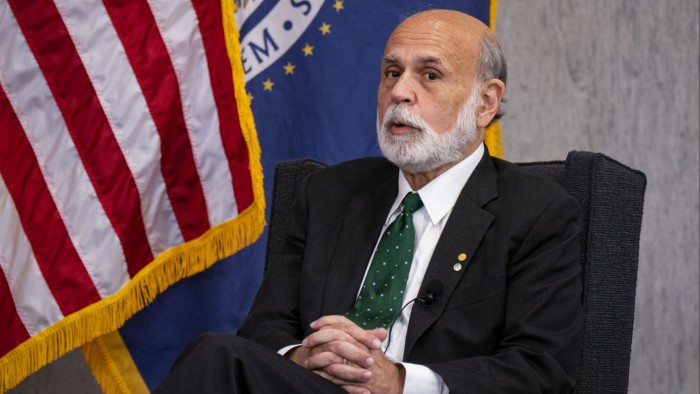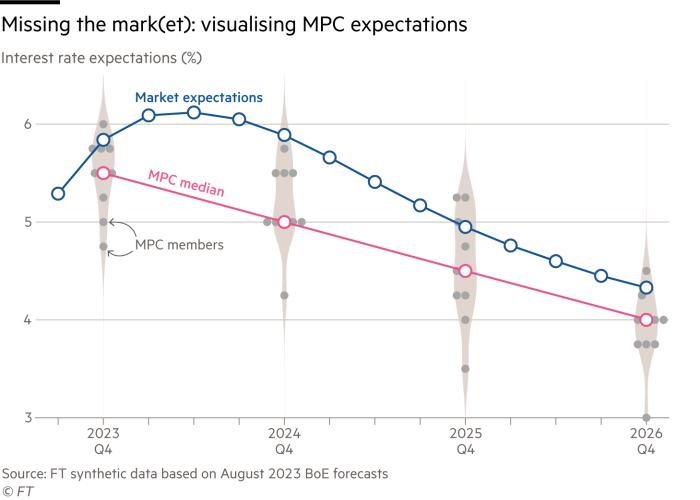Chris Giles on how to solve the Bank of England’s forecasting problem

Simply sign up to the Central banks myFT Digest -- delivered directly to your inbox.
This article is an on-site version of our Chris Giles on Central Banks newsletter and is free to read today. If you’re an FT Premium subscriber, you can sign up here to get the newsletter sent straight to your inbox every Tuesday. You can also upgrade your subscription here.
Hello and welcome to Chris Giles on Central Banks, my weekly newsletter covering the global economy, inflation, monetary policy and financial stability — in short, everything the officials in these august institutions need to worry about.
After 19 years as economics editor at the FT, I’ve moved into a new role as economics commentator. So, expect less reporting, more opinion and more of me. This week I am going to focus on the forecasting and communication crisis that has engulfed central banks since inflation took off two years ago. Please send your thoughts, comments and ideas to chris.giles@ft.com.
Turning the tables on a reporter
A couple of weeks ago I asked Ben Bernanke for an interview about his review of the Bank of England forecasting and communications. He declined and, instead, asked to interview me. Of course, I agreed. Let’s be clear, everything that follows was what I said to the former Federal Reserve chair. It potentially offers zero insight into the results of his review. We can all regroup when it is published and you can either praise my influence or point and laugh.
It has been a tough time globally for central banks — you know, losing control of price stability and all that — but why the BoE? For me, trust ratings are central (see the chart below). The Fed is historically pretty unpopular, according to the latest Gallup poll, although officials can partly blame US Republicans who support institutions only when their candidate is in the White House (Democrats are less partisan). The European Central Bank had a terrible image crisis a decade ago during the euro crisis but has maintained trust recently. But the BoE has seen its satisfaction ratings plummet. Not surprising perhaps, when it has lost control of prices, forecast phantom recessions and made numerous gaffes.
To its credit, the BoE has accepted that it has lessons to learn and called for help from Bernanke, who was Fed chair between 2006 and 2014. He has started the review and from what I hear internally at the BoE, this is not one of those exercises where staff have already written the report desired by senior officials and all Bernanke has to do is add his signature and collect his fee.
So, what’s wrong?
When chatting to Bernanke, I reeled off a list of things that had gone wrong. The BoE’s forecasting and communications processes work badly, I said, somewhat stating the obvious. Producing six forecasts every quarter — a mode, mean and median for a set of forecasts based on financial market expectations and another mode, mean and median for forecasts based on constant interest rates — guarantees it is almost impossible to understand what has changed in the outlook and allows officials to pick and choose a different forecast when it suits them, making them appear shifty. This has to go.
BoE officials are very wedded to keeping their almost 30-year-old “fan chart” inflation forecasts, which attempt to convey uncertainty, but these fail on almost every level, I said. The width of the uncertainty band does not reflect past forecast errors and is simply invented by the Monetary Policy Committee. Worse, when officials say that “risks lie on the downside” and inflation is more likely to undershoot than overshoot the central forecast, they give the impression that a model has spewed out thousands of forecasts and that is the result. In truth, the MPC just makes up a number — currently 0.4 — that represents their “best collective judgment” of the difference in three years’ time between inflation in the central forecast (mode) and the risk-adjusted forecast (mean). Naturally, no one reports this grotesque complexity, although I did once try.
The forecasts are, therefore, the worst of all worlds. The invented uncertainty parameter is often so wide as to make the BoE’s view of the future impossible to determine, while the risk parameter has spurious precision. Together, that makes it impossible to see the changes in forecasts clearly and the BoE can always use the complexity to wriggle out of accountability. This can make life easier in the short term, but as we’ve seen from public satisfaction it is incredibly dangerous for a central bank.
Stop being rude and be constructive
Bernanke didn’t exactly ask me to, but I did feel the need to offer some solutions. Setting interest rates requires a view of the future, so the process of producing and communicating forecasts is vital for almost all central banks. The beauty is that there are a lot of alternative models on offer. But first, you should come up with some principles to guide thinking. I offered four.
Clarity: the forecast, changes and policy reasoning should be easy to understand
Consistency: forecasts should be consistent with market prices
Accountability: each MPC member should be accountable for their expectation of future interest rates needed to control inflation as well as their vote on current interest rates
Humility: there needs to be a clear recognition of the uncertainty surrounding forecasts
In the BoE’s context, where each MPC member is individually accountable, I said it made most sense for an ECB-style single central forecast instead of the bank’s six and for it to be produced by officials and called the “staff forecast”. The MPC would obviously be involved in its production, but the staff would have the final say and own the forecast. This would be based on market expectations of future interest rates, which almost certainly would not match MPC members’ own expectations of what is needed.
Because members of the MPC are likely to disagree with each other and the financial markets about the appropriate path of interest rates, I said MPC members should individually write down their preferred path of interest rates for the end of each of three years into the future.
These would be published with the individuals’ names attached. This would create a Fed-style dot plot to provide some information to the public about where interest rates are likely to move and over what timescale. MPC members would then be expected to account for their views when giving evidence to parliament and reveal why they have changed their minds, which will inevitably happen. I’ve mocked up a potential chart below highlighting how the views might have looked at the time of the August 2023 Monetary Policy Report, when all six inflation forecasts suggested price rises would fall below the 2 per cent target, so presumably, the MPC expected lower rates at the time than the market path.

An alternative, I said was to go “full-Fed” and have each MPC member produce their own economic forecast based on what they deemed the “appropriate monetary policy”. All nine could then be published in summary form, again with names attached to encourage accountability. I said this had advantages in clearly answering the question — “what needs to happen to interest rates to achieve price stability?” — but would result in nine forecasts and some quite difficult issues of consistency between the forecasts and existing financial market prices.
The big point is not the exact model but the understanding that there is a problem and there are better ways to run and communicate monetary policy. Transparency and accountability are key for regaining trust and the sky does not fall when you show your working.
What I’ve been reading and watching
Federal Reserve officials, through the September minutes of the Federal Open Market Committee and speeches by vice-chair Philip Jefferson and Dallas Fed president Lorie Logan have tempered expectations of another US rate rise.
Claudia Sahm, the former Fed economist, writing in the FT, argues that the US central bank’s forecasts and communications have their own problems. It’s persuasive, but the BoE would be delighted if these were its only concerns.
Richard Barwell, head of macro research at BNP Paribas Asset Management, argues that central bankers might struggle with the message that they will hold rates high for a long time.
The IMF was extremely hawkish in its advice to central banks at its annual meeting last week. It has based some of the advice for tight monetary policy on this new research arguing it takes some time for people to expect persistently lower inflation. The research is based on past trends and I worry the future might not be so similar.
An event for your diaries
To coincide (almost) with the FT launching this newsletter, I’ll be talking to my international colleagues Martin Arnold, Claire Jones, Martin Sandbu and Colby Smith to unpick the lessons from central banks’ battle against inflation. Register now for your ticket and send in your questions for the panel here.
A chart that matters
Last Thursday, the core US consumer price index was a little stronger than expected. Inflation is still coming down, but when you look at price trends over the past month and past three months, the good news from the summer ended. This is a trend Fed officials must hope will soon end.


Comments